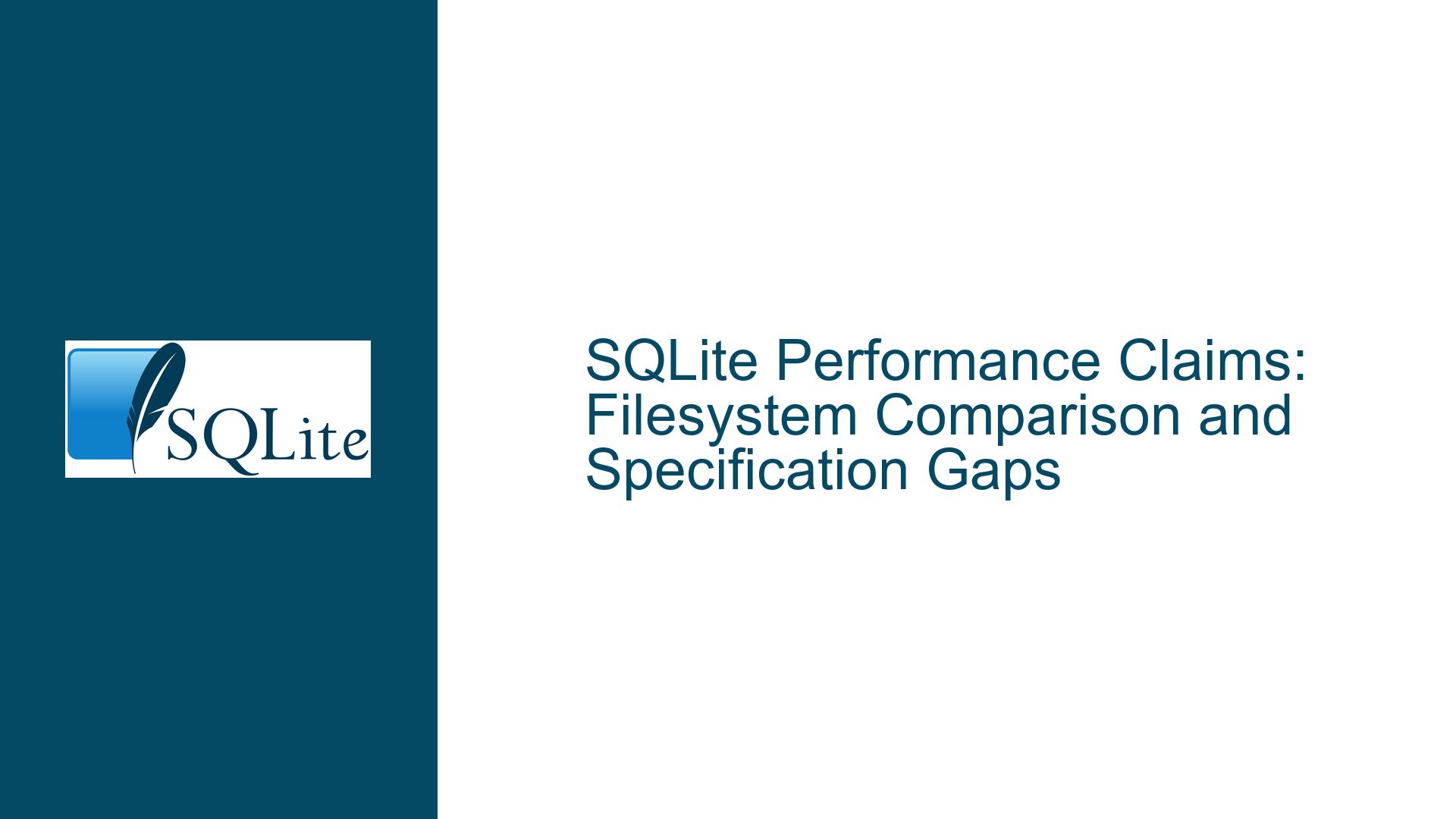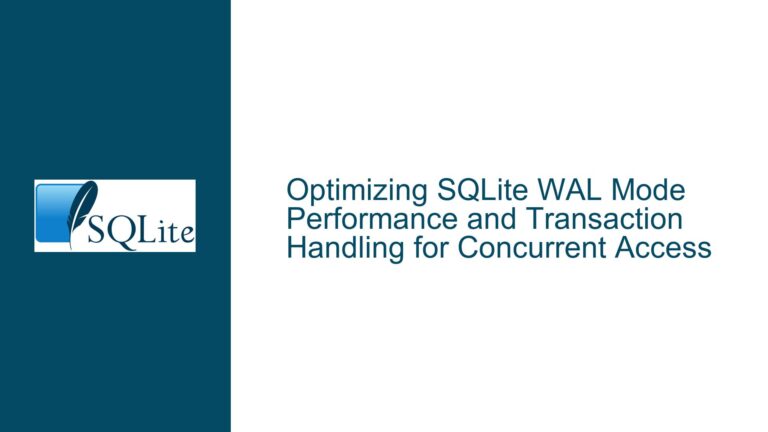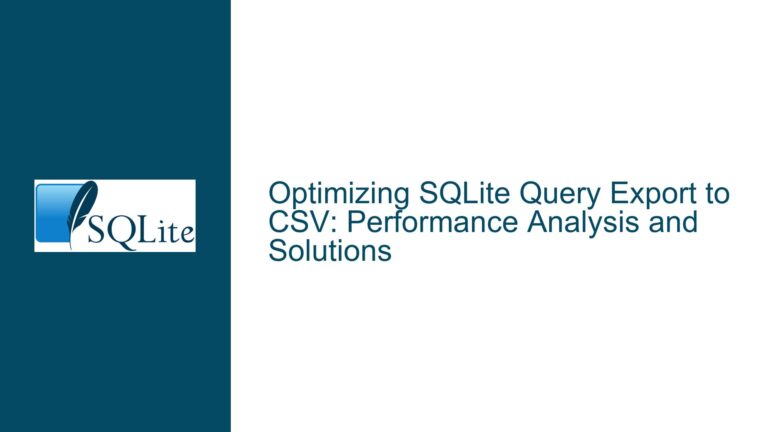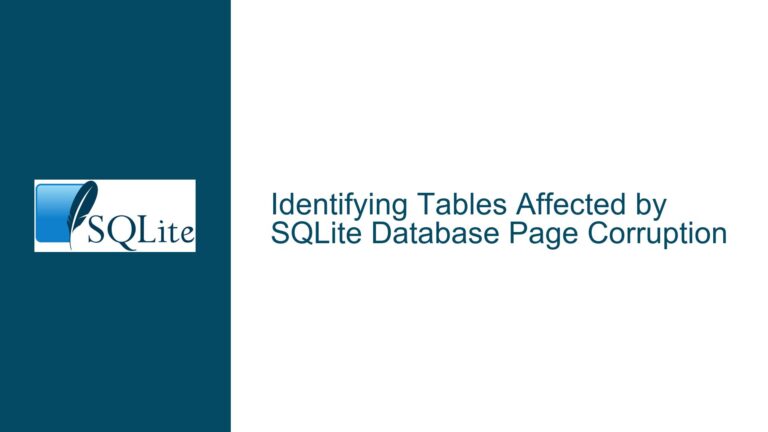SQLite Performance Claims: Filesystem Comparison and Specification Gaps
SQLite Outperforming Filesystem Access: Context and Misconceptions
The claim that SQLite can be "35% faster than the filesystem" has sparked significant debate and confusion. This assertion, while intriguing, lacks critical context and specificity, particularly regarding the filesystems being compared. SQLite is a lightweight, embedded relational database management system (RDBMS) designed for efficiency and simplicity. It operates within a single file, leveraging its own indexing and storage mechanisms to manage data. On the other hand, filesystems like ext4, NTFS, or APFS are responsible for managing files and directories on storage devices, providing a layer of abstraction between the operating system and the physical storage media.
The comparison between SQLite and filesystem performance is not straightforward. SQLite’s performance advantage, as cited, stems from its ability to bypass certain filesystem overheads, such as directory traversal and file metadata lookups. However, this advantage is highly dependent on the specific use case, the filesystem in question, and the nature of the operations being performed. For instance, SQLite’s performance benefits are more pronounced in scenarios involving frequent read/write operations on small datasets, where the overhead of filesystem operations can become significant. In contrast, for large file transfers or operations that benefit from filesystem-level optimizations, SQLite may not offer the same performance gains.
The lack of filesystem specification in the original claim is a critical oversight. Filesystems vary widely in their design, performance characteristics, and optimizations. For example, ext4, commonly used in Linux, employs techniques like delayed allocation and extent-based file storage to improve performance. NTFS, used in Windows, offers features like journaling and advanced indexing for large volumes. APFS, designed for Apple devices, focuses on encryption and snapshots. Without specifying which filesystems were used in the comparison, the claim becomes ambiguous and difficult to validate.
Moreover, the comparison fails to account for the different roles SQLite and filesystems play. SQLite is optimized for structured data storage and retrieval, offering features like transactions, indexing, and query optimization. Filesystems, on the other hand, are designed for general-purpose file management, supporting a wide range of file types and operations. Comparing the two directly without considering their respective strengths and use cases can lead to misleading conclusions.
Ambiguity in Filesystem Specifications and Performance Benchmarks
The ambiguity surrounding the filesystems used in the performance comparison is a significant issue. Without clear specifications, it is impossible to replicate the benchmarks or understand the conditions under which SQLite outperformed the filesystem. This lack of detail undermines the credibility of the claim and makes it difficult for users to assess its validity.
One possible cause of this ambiguity is the assumption that readers are familiar with the default filesystems used in different operating systems. For example, the article may have assumed that readers would infer the use of ext4 on Linux, NTFS on Windows, and APFS on macOS. However, this assumption is problematic, as users may be working with different filesystems or configurations that could yield different results. Additionally, the performance characteristics of filesystems can vary significantly based on factors like disk type (HDD vs. SSD), file size, and workload type (random vs. sequential access).
Another potential cause is the oversimplification of the comparison. The claim that SQLite is "35% faster than the filesystem" does not specify the nature of the operations being compared. For example, SQLite may excel in scenarios involving frequent small reads and writes, where its indexing and caching mechanisms reduce overhead. However, for large file transfers or operations that benefit from filesystem-level optimizations, SQLite may not offer the same performance advantages. Without detailed information about the benchmarks, it is impossible to determine the validity of the claim or its applicability to different use cases.
The lack of filesystem specification also raises questions about the methodology used in the performance comparison. Were the benchmarks conducted on a single filesystem, or were multiple filesystems tested? Were the tests performed on different operating systems, or were they limited to a specific environment? Were the results averaged across multiple runs, or do they represent a single data point? These questions highlight the importance of transparency in performance benchmarking and the need for detailed documentation to support any claims.
Clarifying Filesystem Comparisons and Validating SQLite Performance Claims
To address the issues raised by the ambiguous performance claims, it is essential to provide a clear and detailed comparison of SQLite and filesystem performance. This comparison should include the following elements:
Filesystem Specification: The comparison should explicitly state which filesystems were used in the benchmarks. This includes specifying the operating system, disk type, and any relevant configuration settings. For example, if the benchmarks were conducted on Linux, the comparison should specify whether ext4, XFS, or another filesystem was used. Similarly, if the tests were performed on Windows, the comparison should indicate whether NTFS or ReFS was used.
Benchmark Methodology: The comparison should provide a detailed description of the methodology used in the benchmarks. This includes specifying the nature of the operations being performed (e.g., random reads, sequential writes), the size of the datasets, and the number of iterations. The methodology should also describe any tools or scripts used to conduct the benchmarks and how the results were measured and recorded.
Performance Metrics: The comparison should include a comprehensive set of performance metrics, such as throughput, latency, and IOPS (input/output operations per second). These metrics should be presented in a clear and consistent format, allowing readers to easily compare the performance of SQLite and the filesystem. Additionally, the comparison should include any relevant graphs or charts to visualize the results.
Use Case Analysis: The comparison should analyze the performance results in the context of specific use cases. For example, it should highlight scenarios where SQLite outperforms the filesystem and scenarios where the filesystem may be more efficient. This analysis should consider factors like dataset size, access patterns, and workload type.
Validation and Reproducibility: The comparison should provide sufficient detail to allow other users to reproduce the benchmarks and validate the results. This includes sharing any scripts, tools, or datasets used in the benchmarks and providing step-by-step instructions for conducting the tests. Additionally, the comparison should encourage users to share their own results and experiences, fostering a collaborative and transparent approach to performance benchmarking.
By addressing these elements, the comparison can provide a more accurate and meaningful assessment of SQLite’s performance relative to filesystems. This, in turn, can help users make informed decisions about when and how to use SQLite in their applications.
Implementing Transparent and Reproducible Performance Benchmarks
To ensure the validity and reliability of performance claims, it is essential to implement transparent and reproducible benchmarks. This involves adopting best practices for benchmarking, documenting the methodology and results, and encouraging community participation in the validation process.
Adopting Best Practices for Benchmarking: Best practices for benchmarking include using standardized tools and methodologies, conducting multiple iterations to account for variability, and controlling for external factors that could influence the results. For example, benchmarks should be conducted on a clean system with minimal background processes to ensure consistent performance. Additionally, benchmarks should be run multiple times to account for any variability in the results.
Documenting Methodology and Results: Detailed documentation is essential for ensuring the transparency and reproducibility of benchmarks. This includes documenting the hardware and software configuration, the specific steps taken to conduct the benchmarks, and the results obtained. Documentation should also include any scripts or tools used in the benchmarks, as well as any assumptions or limitations that may affect the results.
Encouraging Community Participation: Encouraging community participation in the benchmarking process can help validate the results and identify any potential issues or biases. This can be achieved by sharing the benchmarking methodology and results with the community, inviting feedback and suggestions, and encouraging users to conduct their own benchmarks and share their results. Community participation can also help identify additional use cases and scenarios that may not have been considered in the original benchmarks.
Addressing Potential Biases and Limitations: It is important to acknowledge and address any potential biases or limitations in the benchmarking process. For example, benchmarks conducted on a specific hardware configuration may not be representative of performance on other systems. Similarly, benchmarks that focus on a specific workload may not capture the full range of performance characteristics. By acknowledging these limitations, the benchmarking process can provide a more accurate and balanced assessment of performance.
Continuous Improvement and Iteration: Performance benchmarking is an ongoing process that requires continuous improvement and iteration. As new hardware and software technologies emerge, benchmarks should be updated to reflect these changes. Additionally, feedback from the community should be used to refine the benchmarking methodology and address any issues or concerns. By adopting a continuous improvement approach, the benchmarking process can remain relevant and provide valuable insights into performance.
Conclusion
The claim that SQLite can be "35% faster than the filesystem" highlights the importance of context, specificity, and transparency in performance benchmarking. Without clear filesystem specifications and detailed methodology, such claims can be misleading and difficult to validate. By adopting best practices for benchmarking, documenting the methodology and results, and encouraging community participation, it is possible to provide a more accurate and meaningful assessment of SQLite’s performance relative to filesystems. This, in turn, can help users make informed decisions about when and how to use SQLite in their applications, ensuring optimal performance and reliability.






